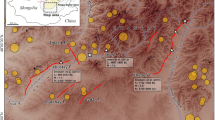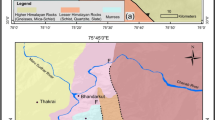Abstract
Kanchankayi is located in the central part of the 55 km long Kurlagere-Gogi-Gundanahalli (KG) fault of Meso-Neoproterozoic Bhima basin of Southern India. Intensive integrated exploration in Kanchankayi has established a concealed, fracture-controlled, low-grade uranium deposit. Uranium mineralisation is mostly confined within the fractured limestone of Shahabad Formation and partly within fractured basement granite. Tectonic movements along the KG fault in Kanchankayi area have resulted in the northward thrusting of basement granite over the Bhima sediments forming a reverse fault geometry. Structural mapping and subsurface exploration has established that the uranium mineralisation is mainly confined to the fault zone. In general, the fault zone is characterised by steep southerly dipping to vertical limestone beds. Iso-dip contouring was attempted on the beds having equal angle of dip, with the premise that steep southerly dipping and vertical beds will reveal the trend and location of the fault zone on the surface. The iso-dip contour map reveals that the contour depicting the fault zone initially follows the basement-sediment contact and further NE i.e. towards Kanchankayi and transgresses into the Bhima sediments. This suggests that the fault zone, instead of following the basement-sediment contact, moves within the basin in Kanchankayi. Recent sub-surface exploration in Kanchankayi has corroborated this interpretation. The innovative approach in utilizing structural mapping and iso-dip contouring has not only given a new dimension to the exploration programme at Kanchankayi but also provided a model technique for exploration of concealed, structure-controlled, hydrothermal, vein-type uranium mineralisation in parts of Bhima basin.
Similar content being viewed by others
References
Achar, K.K., Pandit, S.A., Natarajan, V., Kumar, Mary, K. and Dwivedy, K.K. (1997) Uranium mineralisation in the Neoproterozoic Bhima Basin, Karnataka, India. In: Recent Developments in Uranium Resources, Production and Demand, IAEA, Vienna, p.1–22.
Akhtar, K. (1977) Depositional environment dispersal pattern and palaeography of the clastic sequence in the Bhima Basin, Indian Mineralogist, v.18, p.65–72.
AMD (2014) Unpublished Status Report of Gogi-Kurlagere fault zone, Bhima basin Investigations, Southern region, Bangalore, p.10.
Baudemont, D. and Fedorowich, J. (1996) Structural control of uranium mineralization at the Dominique-Peter Deposit, Saskatchewan, Canada. Econ. Geol., v.91, pp.855–874. DOI:/https://doi.org/10.2113/gsecongeo.91.5.855.
Biswal, T.K., Sivalingam, B., Sharma and Neeraj, K. (2019) Basin inversion, back thrust and strike-slip tectonics: Implications on uranium mobilization in Gogi-Ukinal areas of Proterozoic Bhima basin, Karnataka. National seminar on Strategic Mineral Exploration for Sustainable Development-Emerging Trends and Challenges. Atomic Minerals Directorate for Exploration and Research, Southern Region, Abstract vol., pp.7–8.
Chaki Anjan, Pandit, S.A. and Achar, K.K. (2004) An appraisal of uranium exploration in the Kaladgi-Badami and Bhima basins in Karnataka and identification of potential targets for uranium exploration by Geophysical Methods. Exploration and Research for Atomic Minerals, v.15, pp.13–24.
Cuney, (2009) Extreme diversity of uranium deposits M. Mineralium Deposita, v.44, pp.3–9.
Dahlkamp, F.J. (1993) Uranium ore deposits, Springer-Verlag, Berlin, 460p.
De Voto, R.H. (1978) Uranium geology and exploration, Colorado School of Mines, USA, 400p.
Dey, S. (2015) Geological history of the Kaladgi-Badami and Bhima basins, south India: sedimentation in a Proterozoic intracratonic setup. Geol. Soc., London, Mem., chapter 19, v.43, pp.283–296. DOI:https://doi.org/10.1144/M43.19.
Dhana Raju, R, Mary K Kumar, Babu, E.V.S.S.K. and Pandit, S.A. (2002). Uranium mineralisation in the Neo-Proterozoic Bhima Basin at Gogi and near Ukinal — Ore petrology and mineral chemistry. Jour. Geol. Soc. India, v.59, pp.299–321.
Jaireth, S., Roach, I.C., Bastrakov, E. and Liu, S. (2016). Basin-related uranium mineral systems in Australia: A review of critical features. Ore Geol. Rev., v.76, pp.360–394. DOI:https://doi.org/10.1016/j.oregeorev.2015.08.006.
Janssen, C., Wenk, H.R., Wirth, R, Morales, L, Kemnitz, H., Sulem, J. and Dresen G. (2016) Microstructures and their implications for faulting processes Insights from DGLab core samples from the Gulf of Corinth. Jour. Struct. Geol., v.86, pp.62–74.
Jayaprakash, A.V. (1999) Evolutionary history of Bhima basin. In: Field Workshop on integrated evaluation of Kaladgi and Bhima basin. Geological Society of India, Abstract Volume, pp.22–28.
Kale, V.S., Mudholkar, A.V, Phansalkar, V.G. and Peshwa, V.V. (1990) Stratigraphy of the Bhima Group. Jour. Palaeontol. Soc. India, v.35, pp.91–103.
Kale, V.S. and Peshwa, V.V. (1995) Bhima Basin, Geological Society of India, Bangalore p. 10 and 69.
Kim, Y., Peacock, D. and Sanderson, D. (2004). Fault damage zones. Jour. Struct. Geol., v.26, pp.503–517.
Li, Z., Chi, G., Bethune, K.M., Bosman, S.A. and Card, C.D. (2015). Geometric and Hydrodynamic Modelling and Fluid-structural Relationships in the Southeastern Athabasca Basin and Significance for Uranium Mineralization. In: E.G. Potter and D.M. Wright (Eds.), Targeted Geoscience Initiative 4: unconformity-related uranium systems. Geol. Surv Canada, Open File 7791, pp.103–114. DOI:https://doi.org/10.4095/295776.
Mahendra Kumar, K., Rai, A.K. and Parihar, P.S. (2014) Ore genesis of Gogi Uranium Deposit in Bhima Basin, Yadgir District, Karnataka, India, Proceedings of the International symposium on Uranium raw material for the nuclear fuel cycle: Exploration, mining, Production, supply and demand, Economics and environmental Issues (uram 2014), v.1, pp.523–539.
Mishra, R.N., Jayaprakash, A.V., Hans, S.K. and Sundaram, V. (1987). Bhima Group of Upper Proterozoic — A Stratigraphic puzzle. Mem. Geol. Soc. India, no.6, pp.227–237.
Nagarajan, R., Madhavaraju, J., Armstrong-Altrin, J.S. and Nagendra, R. (2011) Geochemistry of neoproterozoic limestones of the Shahabad formation, Bhima basin, Karnataka, southern India. Geosciences Jour., v.15, pp.9–25.
Pandit, S.A., Natarajan, V. and Dhana Raju, R. (2002) Exploration for uranium in the Bhima basin in parts of Karnataka, India. Exploration and Research for Atomic Minerals, v.14, pp.59–78.
Patnaik, S., Chakrabarti, K., Pradhan, A.K. and Bhattacharya, D. (2016) Petrographic characteristics of carbonaceous matter associated with brecciated limestone at Kanchankayi area, Yadgir district, Karnataka: Genetic implications for uranium mineralization, Jour. Appld. Geochemistry, v.18(3), pp.119–124.
Patnaik, S., Hegde, G.N., Panneerselvam, A., Verma, M.B., Mohanty, R. and Rai, A.K. (2016) Geochemical behaviour of LREE, Y and Zr in uranium mineralized and non-mineralized granite from Darshanapur area, in the Gogi-Kurlagere fault zone, Bhima basin, Yadgiri district, Karnataka. Jour. Geol. Soc. India, v.88, pp.151–158, DOI:https://doi.org/10.1007/s12594-016-0474-x.
Roy, Debasish, Bhattacharya, D., Mohanty, R., Patnaik, S., Pradhan, A.K., Chakrabarti, K. and Zakaulla, S. (2016) Study of Deformation pattern in Gogi-Kurlagere fault zone at Gogi-Kanchankayi sector of Proterozoic Bhima Basin of northern Karnataka: its implication in control of uranium mineralization. Jour. Explorat. Res. Atomic Minerals, v.26, pp.157–176.
Ruzicka, V. (1993) Vein Uranium Deposits. Ore Geol. Rev., v.8(3 and 4), pp.247–276.
Senthil Kumar, P. and Srinivasan, R. (2002) Fertility of late Archaean basement granite in the vicinity of U-mineralized Neoproterozoic Bhima basin, peninsular India. Curr. Sci., v.82, pp.571–575.
Verma, M.B., Nanda, L.K., Bhatt, A.K., Chakrabarti, K. and Hegde, G.N. (2018) Structural control of uranium mineralisation in Bhima basin Karnataka. National Seminar on Dynamics of Surface and Subsurface Geological Processes. Pondicherry University, Abstract Volume, pp.107–108.
World Distribution of Uranium Deposits (UDEPO) (2016) International Atomic Energy Agency, p.247.
Acknowledgement
The authors thank Director, AMD for granting permission to publish this work. Constructive suggestions and comments by anonymous reviewers which helped in improving the quality of the manuscript are thankfully acknowledged.
Author information
Authors and Affiliations
Corresponding author
Rights and permissions
About this article
Cite this article
Roy, D., Pande, D., Chakrabarti, K. et al. Iso-dip Contouring: An Innovative Approach to Exploration for Concealed, Structure-controlled, Hydrothermal, Vein-type Uranium Mineralisation in Kanchankayi Sector of Kurlagere-Gogi-Gundanahalli Fault Zone, Yadgir District, Karnataka. J Geol Soc India 96, 232–238 (2020). https://doi.org/10.1007/s12594-020-1542-9
Received:
Accepted:
Published:
Issue Date:
DOI: https://doi.org/10.1007/s12594-020-1542-9




